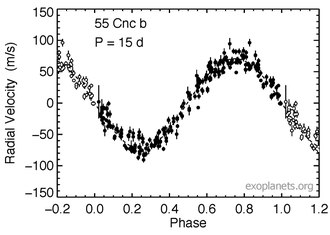Galileo (exoplanet)
|
Exoplanet Galileo |
|
|---|---|
| Artist's impression | |
| Constellation | cancer |
| Position equinox : J2000.0 |
|
| Right ascension | 08h 52m 35.81093s |
| declination | + 28 ° 19 ′ 50.9511 ″ |
| Orbit data | |
| Central star | Copernicus A |
| Major semi-axis | 0.11339 ± 0.00011 AU |
| eccentricity | 0.0023 +0.0025−0.0016 |
| Period of circulation | 14.6531 +0.0009−0.00095 |
| Further data | |
| Dimensions | 0.84 +0.23−0.031 M J |
| distance | 12.5 pc |
| method | Radial velocity method |
| Orbit inclination | 89.73 +24.49−24.54 deg |
| history | |
| discovery | R. Paul Butler et al. |
| Date of discovery | April 12, 1996 |
| Catalog names | |
| 55 Cancri b, HD 75732 b | |
Galileo ( 55 Cancri b ) is an exoplanet orbiting the more massive component A of the binary star system Copernicus , a yellow dwarf . The system is located in the constellation Cancer , about 40 light years from Earth . Galileo is part of a planetary system with at least five planets . Due to its high mass , it is believed to be a gas planet . It is the second planet from its star and was the fourth known planet around a normal star when it was discovered in 1996. Four other large planets were later discovered around Copernicus A, one within and three outside of Galileo's orbit.
discovery
Galileo was discovered using the radial velocity method , which consists of measuring the effect of a planet's gravity on its star . The planet was discovered on April 12, 1996 in California by a team of astronomers led by Geoffrey Marcy and R. Paul Butler and published together with Tau Bootis b and Saffar . After Dimidium, these three formed the closest known representatives of the genus “ Hot Jupiter ”, massive planets with very narrow and almost circular orbits.
Track properties
The planet orbits its star at a distance of 0.11 AU , only 11% of the distance between the sun and the earth. It may have a 1: 3 orbital resonance with the nearest planet Brahe . Every 14.65 days (1.266 × 10 6 s) it orbits Copernicus A on an almost circular orbit (eccentricity of only 0.014), which is about 4 times longer than that of Janssen . Some observations show that this planet has an inclination of 51 °, which is not yet confirmed.
Physical Properties
The minimum mass is 0.824 M J or 261.74 M ⊕ (1.5635 × 10 27 kg). The real mass is probably even a little higher than that of Jupiter. The planet has a radius of at least 0.58 times the radius of Jupiter (41 × 10 3 km). Since this planet was discovered indirectly through the influence of gravity on Copernicus A, some of its properties such as the radius are uncertain or unknown. Composition, temperature and appearance are unknown and the subject of speculation. Galileo is believed to be a hot Jupiter , that is, a planet with a mass similar to that of Jupiter and a relatively high surface temperature, mainly caused by its proximity to its star. Presumably, the planet has a cloudless upper atmosphere with a spectrum dominated by the absorption lines of the alkali metals . Galileo should not have any larger moons because the tidal forces are too strong .
Origin of name
Like all exoplanets, Galileo was originally designated with the star's official name and a lowercase letter, according to the order in which it was discovered. After a public IAU competition , it was given an official name on December 15, 2015 after the Italian scientist and astronomer Galileo Galilei .
See also
swell
- RP Butler et al .: Three New "51 Pegasi-Type" Planets. The Astrophysical Journal, 474 (1997): L115 - L118. doi: 10.1086 / 310444
Web links
- Nasa Exoplanet Archives
- Extrasolar Visions: 55 Cancri b ( Memento from May 9, 2012 in the Internet Archive )
Individual evidence
- ↑ Simbad
- ↑ a b c d e f g Exoplanet.eu
- ^ Van Leeuwen, F .: HIP 43587 . In: Hipparcos, the New Reduction . 2007. Accessed February 16, 2013.
- ↑ Debra A. Fischer et al .: Five Planets Orbiting 55 Cancri. The Astrophysical Journal , 675 (2008), pp. 790-801. doi: 10.1086 / 525512 , arxiv : 0712.3917 .
- ↑ D. Sudarsky et al .: Theoretical Spectra and Atmospheres of Extrasolar Planets Giant. The Astrophysical Journal, 588 (2) (2003): 1121-1148. doi: 10.1086 / 374331 .
- ^ J. Barnes, D. O'Brien: Stability of Satellites around Close-in Extrasolar Giant Planets. The Astrophysical Journal, 575 (2) (2002): 1087-1093. doi: 10.1086 / 341477 .
- ↑ International Astronomical Union: NameExoWorlds - The Approved Names. Retrieved January 3, 2016 .

